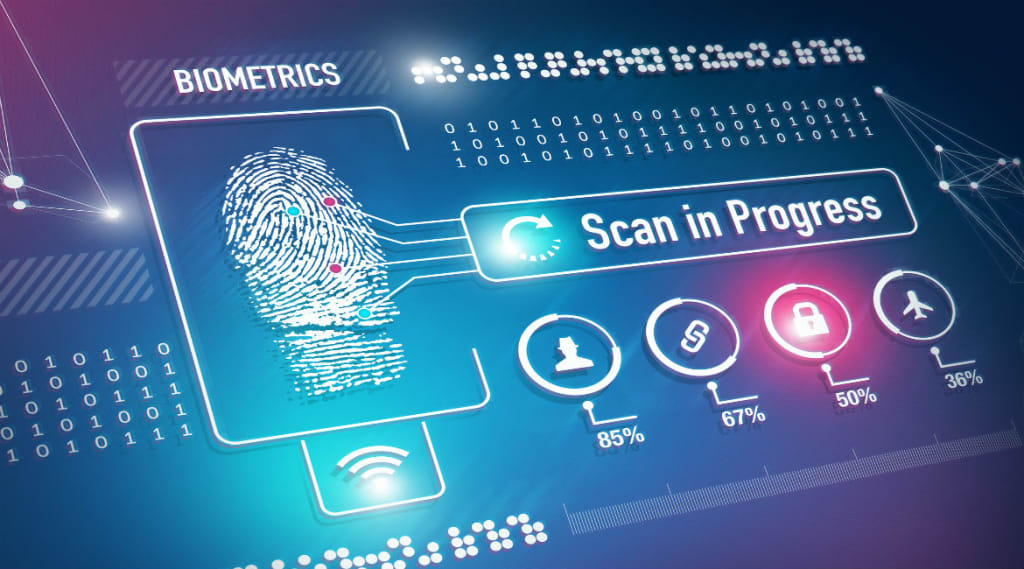Exploring the Role of Biometrics in the Banking Sector
Biometrics can a large impact on the banking sector in terms of security and reducing fraud.

In today's rapidly evolving digital landscape, ensuring robust security measures is paramount for the banking industry. Traditional authentication methods, such as PINs and passwords, are increasingly susceptible to cyber threats and identity theft. To address these challenges, biometrics in banking has emerged as a more secure and reliable solution.
Biometric authentication has gained traction to strengthen security measures and streamline the user experience through advanced fintech app development services. Whether a fingerprint scan on a mobile device or facial recognition at an ATM, biometric authentication offers a seamless way for consumers to interact with their banking services.
In this comprehensive blog, we will explore the role of biometrics in the banking sector, the benefits of biometric technology in banking, and use cases of biometrics in banking, among others.
What is Biometrics in Banking?
Biometrics in banking is a technology that scans the physical characteristics of a user for identification and authorization. The main approaches include facial scans, voice checks, fingerprint mapping, and retina recognition, which are the easiest to implement and use.
To log into an application or perform an operation using biometrics in banking, an individual uses their biometric data to verify their identity. The system scans the data with suitable scanners and matches it against an existing database. This process makes it more difficult for fraudsters to gain unauthorized access to accounts and provides a more convenient identity verification process.
How Does Biometric Authentication Work in the Banking Sector?
Biometric security systems in banking have hardware scanners powered by custom software that processes the collected data. The system's look and functionality depend on the type of data collected. Once activated, the scanner captures the biometric data for identity verification, converts it into digital format, and matches it against an existing database. If the data samples coincide, access is granted; otherwise, access is denied or flagged for review.
Biometrics in Banking Systems Work Through a Three-Stage Process:
Enrollment: A customer's biometric data, such as a fingerprint or facial features, is captured.
Storage: The collected biometric data is encrypted and protected from unauthorized access.
Comparison: The customer's input biometric data is compared with the stored data to verify their identity.
Advantages of Biometric Technology in Banking
As per reports, the estimated value of banking biometrics was $5.2 billion at the beginning of 2023 and is expected to reach $15.2 billion by 2030, growing at a CAGR of 14.4%. The benefits of biometrics for banks include:
Increased Convenience: Eliminates the need to remember complex passwords or carry physical security keys.
Enhanced Security: Provides a high level of security and mitigates fraud and error risks.
Fraud Reduction: Detects and prevents fraudulent activities, alerting banks in real time.
Greater Operational Efficiency: Reduces the need for manual reviews and investigations, saving time.
Types of Biometric Security Implemented in the Banking Industry
Biometric data in banking generally falls into three groups:
Morphological: Physical traits like eye, fingerprint, or face shape.
Biological: Genetic or molecular characteristics, such as DNA or blood.
Behavioral: Unique behavioral patterns like walking or speaking.
The primary biometric modalities in banking are fingerprints and facial recognition, along with finger or palm veins and iris scans.
Key Features of Biometrics in Banking
To implement comprehensive biometrics in banking systems, it is important to embed certain standard features, including:
Transaction Data Signing: Verifies transaction credentials with a one-time confirmation code.
Multi-Factor Authentication: Combines biometric scanning with additional verification steps.
API for Quick Deployment: Facilitates seamless communication between the bank's server and client devices.
Mobile Security: Implements advanced security measures to protect against potential threats.
Examples of Biometric Security Systems in the Banking Sector
To integrate biometrics in banking systems, banks must decide which data to collect. Popular methods include:
Voice Recognition: Measures speech modulation, accent, tones, and frequencies to create a voice print for identification.
Facial Recognition: Captures facial features to generate a face template using convolutional neural network technology.
Fingerprint and Palm Print: Digitizes the orientation of ridges on human fingerprints to create biometric templates.
Iris Recognition: Uses unique patterns of the iris for identification.
Finger Geometry: Captures the shape, length, width, and thickness of fingers.
Signature Recognition: Compares a graphic image of a handwritten signature with a previously saved copy.
How to Make Biometrics in Banking More Secure
To ensure secure integration of biometrics in banking, follow these approaches:
Multiple Means of Authentication: Combine biometric scanning with non-biometric approaches.
Cloud Systems: Cooperate with providers who use cloud development services to keep data secure and encrypted.
Professional Implementation: Hire experienced software development companies to connect the system securely.
Use Cases of Biometrics in the Banking Industry
Biometrics in banking is prevalent for authenticating customers and securing assets. Key applications include:
ATMs: Use facial and fingerprint biometrics for secure transactions.
Mobile Banking: Employ facial biometric authentication for secure access to banking services.
Customer Onboarding: Streamline the KYC verification process, cutting down the time spent on onboarding.
By implementing biometric authentication, banks can enhance security, streamline operations, and improve customer experience, ultimately leading to a more secure and efficient banking ecosystem.
About the Creator
Enjoyed the story? Support the Creator.
Subscribe for free to receive all their stories in your feed. You could also pledge your support or give them a one-off tip, letting them know you appreciate their work.





Comments
There are no comments for this story
Be the first to respond and start the conversation.